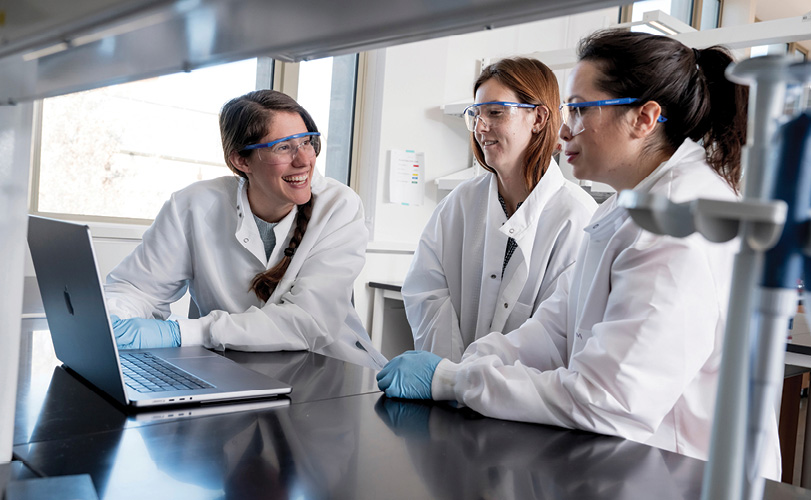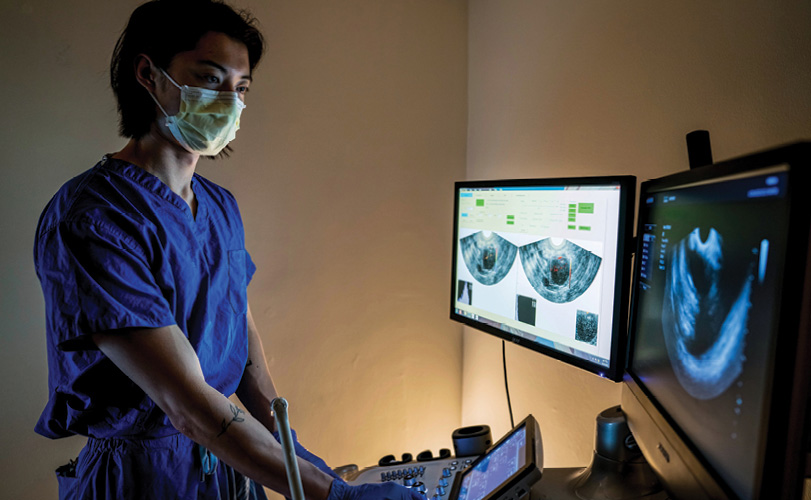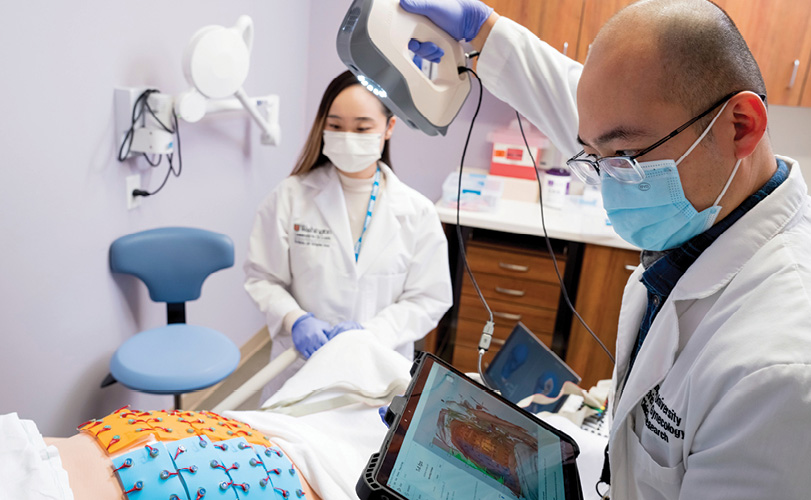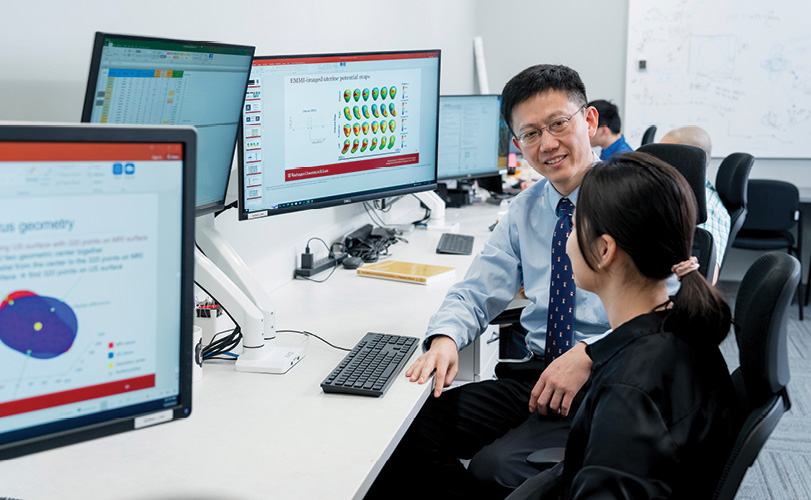Improving women’s health with engineering
Tools and techniques of engineering can be applied to diagnosis, treatment and prevention in women’s health
For decades, women’s health has been an afterthought. As recent as 1993, most testing in clinical trials was conducted on men, and female animals and cells were not required to be included in federally funded testing until 2016. This lack of research focused solely on women’s issues has trickle-down effects on women of all ages, from puberty through post-menopause. Maternal mortality rates are increasing in the U.S., particularly in Black and Native American women, who are three times more likely to die from a pregnancy-related cause than white women. This is in contrast to the decreasing rates of maternal mortality in other developed countries.
Recently, the Centers for Disease Control & Prevention’s Maternal Mortality Review Committees reported that pregnancy-related deaths occurred during pregnancy, delivery and up to a year postpartum. More than 80% were determined to be preventable, and their causes varied by race and ethnicity. More than 80% of the women who died lived in urban areas, and more than half of all pregnancy-related deaths occurred within seven days to one year after delivery.
At Washington University in St. Louis, the McKelvey School of Engineering and the School of Medicine have made women’s health a focus area by adding new faculty whose research is in the field and establishing new interdisciplinary collaborations. Together, they will focus on some of the more understudied and underfunded areas of women’s health, including maternal health and cancers of the reproductive system, from both the engineering and medical research perspectives.
“He took me to the NICU and showed me the tiny premature babies and said, ‘I think we can do something about this, but I think it involves engineering.’”
— Michelle Oyen
As part of the new focus, McKelvey Engineering launched the Center for Women’s Health Engineering, composed of faculty and researchers from McKelvey Engineering and the School of Medicine, in September 2022, naming Michelle Oyen, associate professor of biomedical engineering, director of the Center. When she joined the McKelvey Engineering faculty in January 2022, she worked to unite existing women’s health initiatives at the university and added a unique twist: engineering.
- The U.S. is the only industrialized country with a rising maternal mortality rate.
- The six weeks following birth are very important to the mother’s health.
- The postpartum period extends to 1 year after birth.
- Endometriosis is found in 10% of women and is a leading cause of infertility.
- Missouri ranks 12th in the nation for the worst rate of maternal mortality.
- There are significant sex differences in many diseases and conditions, including autoimmune diseases, cancer, cardiovascular diseases, depression and brain disorders, diabetes, infectious diseases, obesity and substance abuse disorders.
“What we bring to the picture are the tools of engineering, such as in vitro models, benchtop models of biomaterials for tissue engineering, microfluidic devices, microphysiological systems and computational models,” said Oyen, whose research focuses on the placenta, the organ that provides nutrients to a developing fetus. “This goes across all the different areas of engineering, such as sensors, computer science, biomaterials, biomechanics, tissue engineering, medical imaging, artificial intelligence and machine learning. We have all these tools and techniques from our own engineering fields, all of which could be relevant in different problems in women’s health.”
Oyen, whose doctoral research began in bone and cartilage orthopedic biomechanics, came to the intersection of engineering and women’s health after meeting an obstetrician interested in premature birth.
“He took me to the NICU and showed me the tiny premature babies and said, ‘I think we can do something about this, but I think it involves engineering,’” Oyen recalls. “He was a very forward-thinking man. We started collaborating, and by the time I finished my PhD, I was working full-time in the ob-gyn department and doing my PhD on the side.”
While the leading cause of death in women nationally is heart disease, the new Center for Women’s Health Engineering will sharpen its focus on areas including maternal health, preterm birth, pelvic floor disorders and cancers of the reproductive system, which are already areas of strength at WashU and are new areas of focus by the White House.
In June 2022, President Joe Biden and Vice President Kamala Harris released a Blueprint for Addressing the Maternal Health Crisis, which is committed to lowering the rates of maternal death and disease, reducing the disparities in maternal health outcomes and improving the experience during and after pregnancy for women nationwide. The blueprint calls for various federal agencies to focus on this initiative, and several have women’s-health focused research offices.
In addition, members of Congress are working to draw attention to maternal health care. The Black Maternal Health Momnibus Act of 2021 is 12 individual bills that include such actions as extending eligibility for the Women, Infants and Children nutrition program; increasing access to maternity care; and establishing programs to improve maternity care for the incarcerated population. The Tech to Save Moms Act of 2021 promotes telehealth and digital tools that would close racial and ethnic gaps in maternal health outcomes to reduce maternal mortality.

Adrienne Scott, Madison Landeros, Samantha Zambuto, all members of Michelle Oyen’s lab, work on research on the placenta.
The beginnings
With support from Aaron F. Bobick, dean and the James M. McKelvey Professor, and Lori Setton, the Lucy & Stanley Lopata Distinguished Professor and chair of Biomedical Engineering, one of the first steps toward a unified effort in women’s health began in 2020 when Quing Zhu, the Edwin H. Murty Professor at McKelvey Engineering; Yong Wang, associate professor of obstetrics & gynecology in the School of Medicine and of electrical & systems engineering in the McKelvey School of Engineering; Tracy Spitznagle, professor of physical therapy and of obstetrics & gynecology; and Whitney Ross, MD, assistant professor of obstetrics & gynecology, held a symposium for researchers to present their work in fertility, monitoring cervical health, progression of labor and postpartum outcomes.
In March 2020, the Department of Biomedical Engineering and the Department of Obstetrics & Gynecology funded a Women’s Health Technologies Collaboration Initiation Grant pilot program that provided seed grants of up to $30,000 to generate sustaining collaboration between engineering and medical school partners that will be competitive for future external funding. Inaugural recipients of the grant were Christine O’Brien, assistant professor of biomedical engineering, with Antonina Frolova, MD, assistant professor of obstetrics & gynecology; and Philip Bayly, the Lee Hunter Distinguished Professor and chair of the Department of Mechanical Engineering & Materials Science, with Jerry Lowder, MD, associate professor of obstetrics & gynecology.
“ … Other fields, such as cardiovascular science and neuroscience, have benefited from collaborating with engineers. I think it’s really a great time for women’s health to do the same.”
— Sarah England
O’Brien and Frolova collaborated to develop a wearable light-based sensor that would provide an early alert for postpartum hemorrhage, and Bayly and Lowder collaborated to devise a new prediction model to guide surgical decision making in female pelvic organ prolapse surgery based on anatomic measurements. The work of O’Brien and Frolova’s team was recognized as an Honorable Mention Awardee in the National Institutes of Health Technology Accelerator Challenge (NTAC) for Maternal Health.

Key leaders in women’s health at Washington University. From left: Lori Setton, Sarah England, Quing Zhu, Michelle Oyen, and Yong Wang
FemTech
Students from McKelvey Engineering, Olin Business School and the School of Medicine are organizing a FemTech Society that will promote education, innovation and research in technology that addresses these unmet needs in women’s health. Annabella Mascot, a senior majoring in mechanical engineering, is the inaugural president of the society, which will begin holding events this spring.
The FemTech movement, which began in the past five years, arose from research published in Science in June 2021 that found that only 13% of U.S. Patent inventors are women; patents with all-women inventor teams are 35% more likely than all-men teams to focus on women’s health; and that women researchers are more likely to discover women-focused ideas.
“The only way you get more companies in this space is to have women venture capitalists looking at inventions by women inventors and starting companies that are women-led to get the pipeline going,” Oyen said.
In the second year of the program, grants were awarded to Alexandra Rutz, assistant professor of biomedical engineering, and Mary M. Mullen, MD, assistant professor of obstetrics & gynecology, for their work titled “In Vitro Bioelectronic Monitoring of Therapy Response in 3D, Patient-Derived Ovarian Cancer Models”; and to Oyen and Anthony Odibo, MD, the Virginia S. Lang Professor of Obstetrics & Gynecology, for their work comparing clinical ultrasound with quantitative multiphysics models of placental function. In September 2022, the Oyen research team, which now includes Ulugbek Kamilov, assistant professor of computer science & engineering and of electrical & systems engineering, won funding from Wellcome Leap to support their work.
In late 2021, researchers in McKelvey Engineering and the School of Medicine partnered to launch the Women’s Health Technologies Initiative, which aims to apply engineering technology to develop new strategies to improve the detection, diagnosis and treatment of conditions affecting the female reproductive system.
Building a center
While the early efforts created momentum, the new Center for Women’s Health Engineering brings these into the fold to ensure that the area is covered from both the engineering and medical research angles. Its four main focus areas of research, education and training, entrepreneurship and community will allow the work accomplished through the center to go beyond the labs and clinics at WashU through innovation and technology transfer.
Sarah England, the Alan A. and Edith L. Wolff Professor of Medicine, professor of obstetrics & gynecology and interim director of the Center for Reproductive Health Sciences, is one of the key faculty in the Center for Women’s Health Engineering and a leader in getting support for a wider university focus on women’s health. Her research focuses on the molecular mechanisms underlying uterine function during pregnancy. She has collaborated with biomedical engineers in McKelvey Engineering to understand how naturally occurring oxytocin receptor variants affect uterine activity.

Tiger Nie, a doctoral student in Quing Zhu’s lab, works with photoacoustic images of ovarian lesions.
England said as more women enter the fields of engineering, research and medicine, they start asking questions, such as, “why are one in 10 births preterm?” and “why is there not a diagnostic tool to predict it?”
“It’s the perfect time to open a center,” she said. “When we get more diversity in these fields, we start broadening what questions we study. Other fields, such as cardiovascular science and neuroscience, have benefited from collaborating with engineers. I think it’s really a great time for women’s health to do the same.”

From left: Sitai Kou and Tiger Nie, both doctoral students, work in Quing Zhu’s lab developing imaging methods for the early detection of cancer.
England said her previous collaborations with Engineering faculty have been beneficial for her research.
“I look at things differently when I talk to engineers,” she said. “What’s important is that they think about design, structure and mechanics, which is highly complementary to what we do, and now it has me thinking along those lines also. It’s a great collaboration, and I love that we’re doing this in the women’s health space.”
Solving problems
Yong Wang, another faculty leader in the center and women’s health initiative, has a unique role in the center with faculty appointments in both medicine and engineering. Wang brings his engineering research and technology development skills developed while earning a doctorate in biomedical engineering from the engineering school in 2009. Before he joined the faculty of the Department of Obstetrics & Gynecology, he said he didn’t know that preterm birth was so common and sees many ways engineering can contribute, including through fetal monitoring and participation in clinical trials.
“By working together with physicians, we can optimize patient outcome — it’s a win-win solution,” he said. “Physicians have wishes, and we satisfy their wishes by making them customized tools. We have a question raised by the physician, and we look for the tool or invent tools to answer it.”

From left: Doctoral student Josephine Lau and Zichao Wen, MD, instructor of obstetrics & gynecology. Using 3D imaging, Yong Wang can see where a contraction starts and finishes and how it is activated, which could revolutionize the obstetrics practice by helping to determine if a patient is likely to have preterm labor.
Wang’s research builds on what he learned working in the lab of Yoram Rudy, the Fred Saigh Distinguished Professor of Engineering, as a doctoral student developing devices to measure electrical activity in the heart. He has implemented new ways to use imaging methods that are safe for pregnancy, such as ultrasound, electrophysiology and MRI, to monitor electrical and muscle function to determine why some patients get preterm contractions. Using his 3D imaging, Wang can see where a contraction starts and finishes and how it is activated, which could revolutionize the obstetrics practice by helping to determine if a patient is likely to have preterm labor.

Yong Wang’s imaging technology can help to improve clinical diagnosis and treatment of various gynecological conditions.
An often-overlooked aspect of women’s health is how the body responds to changes during and after pregnancy and in peri- and post-menopause. Such changes can result in incontinence, pelvic pain and injuries that occur during birth that can result in long-term issues.

Christine O’Brien
Assistant Professor of Biomedical Engineering
O’Brien’s research focuses on developing translational optical technologies that can improve women’s health care. Her lab develops optical tools that tackle challenges spanning maternal health, reproductive cancers and women’s global health, using optical spectroscopy, optical imaging and simulation techniques that can be translated to impact patient care.
O’Brien and her team are gaining recognition for their work on a light-based, wrist-worn device to monitor and detect hemorrhage after birth. Most recently, she and her team received a $20,000 prize from the National Institutes of Health’s Rapid Acceleration of Diagnostics Technology (RADx Tech) for Maternal Health Challenge, and in July 2022, she and her team were recognized as Honorable Mention Awardees in the National Institutes of Health Technology Accelerator Challenge for Maternal Health.
Tracy Spitznagle has focused much of her career helping women with these issues. As a professor of physical therapy and of obstetrics & gynecology at the School of Medicine and a board-certified specialist in women’s health physical therapy, she leads a women’s health clinical residency in the Program in Physical Therapy that offers specialized training for physical therapists to treat pelvic pain, incontinence and pelvic floor disorders, which affect more than one-third of women by age 60.
“All birthing individuals could benefit from physical therapy because of the profound changes that happen from giving birth,” she said. “From a population health perspective, we ask how we can keep our women more active and healthier and contributing to society at a better level. With healthy women, you have a healthy community.”
Spitznagle sees more collaboration with engineers as a way to increase research in this area.
“It’s exciting to head down a path that isn’t clear because there is a lot of potential for change,” she said. “What we do is an art, not a science, and at times there are some common mechanisms that we still don’t understand. So having engineers help us understand the mechanisms for how some things work or don’t work can really help us, especially if it improves the quality of life for women.”
Back to Engineering Momentum
